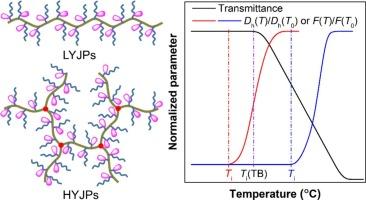超支化y键共聚物的合成及其多可调热响应行为
IF 6.3
2区 化学
Q1 POLYMER SCIENCE
引用次数: 0
摘要
链结构和化学成分对热响应行为起着至关重要的作用。为了丰富超支化聚合物的分子工程和揭示拓扑效应,本研究设计了由2-(N,N-二甲氨基)甲基丙烯酸乙酯和N-(1-(吡啶-1-羰基)羟基烷氧羰基乙基硫乙基)甲基丙烯酰胺单元组成的热/ ph响应型超支化y结承载聚合物(HYJPs)。羟基烷基链长的增加使HYJP水溶液发生了“开/关”的LCST转变,云点(Tc)降低,共聚物组件的形状从球形转变为混合的纳米结构和囊泡,揭示了化学成分的关键作用。随着pH的升高,Tc往往表现出先降低后升高的演化趋势,这是由于酯基的水解提高了亲水性。与线性类似物相比,HYJPs在水中表现出明显的纳米物体形状,降低了Tc,增强了荧光强度,显示出明显的拓扑效应。在热诱导自组装过程中,发生了球/囊泡到纳米带/片层的转变,纳米带和片层的形成导致荧光强度升高,对应于形态转变增强了发射。随着不对称异功能Y结的加入,由于加热时复杂的构象调整,不同透射率、纳米物体尺寸和荧光发射的初始温度通常不同。这项研究的成功奠定了HYJPs的多可调特性和前景应用的基础。本文章由计算机程序翻译,如有差异,请以英文原文为准。

Synthesis and multi-tunable thermoresponsive behaviors of hyperbranched Y-junction-bearing copolymers
Chain architecture and chemical composition can play crucial roles in affecting thermoresponsive behaviors. To enrich molecular engineering of hyperbranched polymers and reveal the topology effect, thermo/pH-responsive hyperbranched Y-junction-bearing polymers (HYJPs) comprising 2-(N,N-dimethylamino)ethyl methacrylate and N-(1-(pyrrolidine-1-carbonyl)hydroxyalkoxycarbonylethylthioethyl) methacrylamide units are designed in this study. The increase of chain length of hydroxyalkyl groups endowed HYJP aqueous solutions with “on/off” LCST transition, decreased cloud point (Tc), and shape shift of copolymer assemblies from spheres to mixed nanostructures and vesicles, revealing the pivotal role of chemical composition. With increasing pH, Tc was usually liable to exhibit the evolution trend of first decreasing and then increasing due to improved hydrophilicity resulting from hydrolysis of ester groups. Compared with linear analogues, HYJPs in water showed distinct nano-object shape, lowered Tc and enhanced fluorescence intensity, revealing pronounced topology effect. Sphere/vesicle-to-nanoribbon/lamella transitions occurred during thermally induced self-assembly, and the formation of nanoribbons and lamellae led to elevated fluorescence intensity, corresponding to morphology transition enhanced emissions. With the incorporation of asymmetric heterofunctional Y junctions, the initial temperatures for varying transmittance, nano-object size and fluorescence emission were usually distinct due to complex conformational adjustment upon heating. The success of this study underlies multi-tunable properties and promising applications of HYJPs.
求助全文
通过发布文献求助,成功后即可免费获取论文全文。
去求助
来源期刊

European Polymer Journal
化学-高分子科学
CiteScore
9.90
自引率
10.00%
发文量
691
审稿时长
23 days
期刊介绍:
European Polymer Journal is dedicated to publishing work on fundamental and applied polymer chemistry and macromolecular materials. The journal covers all aspects of polymer synthesis, including polymerization mechanisms and chemical functional transformations, with a focus on novel polymers and the relationships between molecular structure and polymer properties. In addition, we welcome submissions on bio-based or renewable polymers, stimuli-responsive systems and polymer bio-hybrids. European Polymer Journal also publishes research on the biomedical application of polymers, including drug delivery and regenerative medicine. The main scope is covered but not limited to the following core research areas:
Polymer synthesis and functionalization
• Novel synthetic routes for polymerization, functional modification, controlled/living polymerization and precision polymers.
Stimuli-responsive polymers
• Including shape memory and self-healing polymers.
Supramolecular polymers and self-assembly
• Molecular recognition and higher order polymer structures.
Renewable and sustainable polymers
• Bio-based, biodegradable and anti-microbial polymers and polymeric bio-nanocomposites.
Polymers at interfaces and surfaces
• Chemistry and engineering of surfaces with biological relevance, including patterning, antifouling polymers and polymers for membrane applications.
Biomedical applications and nanomedicine
• Polymers for regenerative medicine, drug delivery molecular release and gene therapy
The scope of European Polymer Journal no longer includes Polymer Physics.
 求助内容:
求助内容: 应助结果提醒方式:
应助结果提醒方式:


